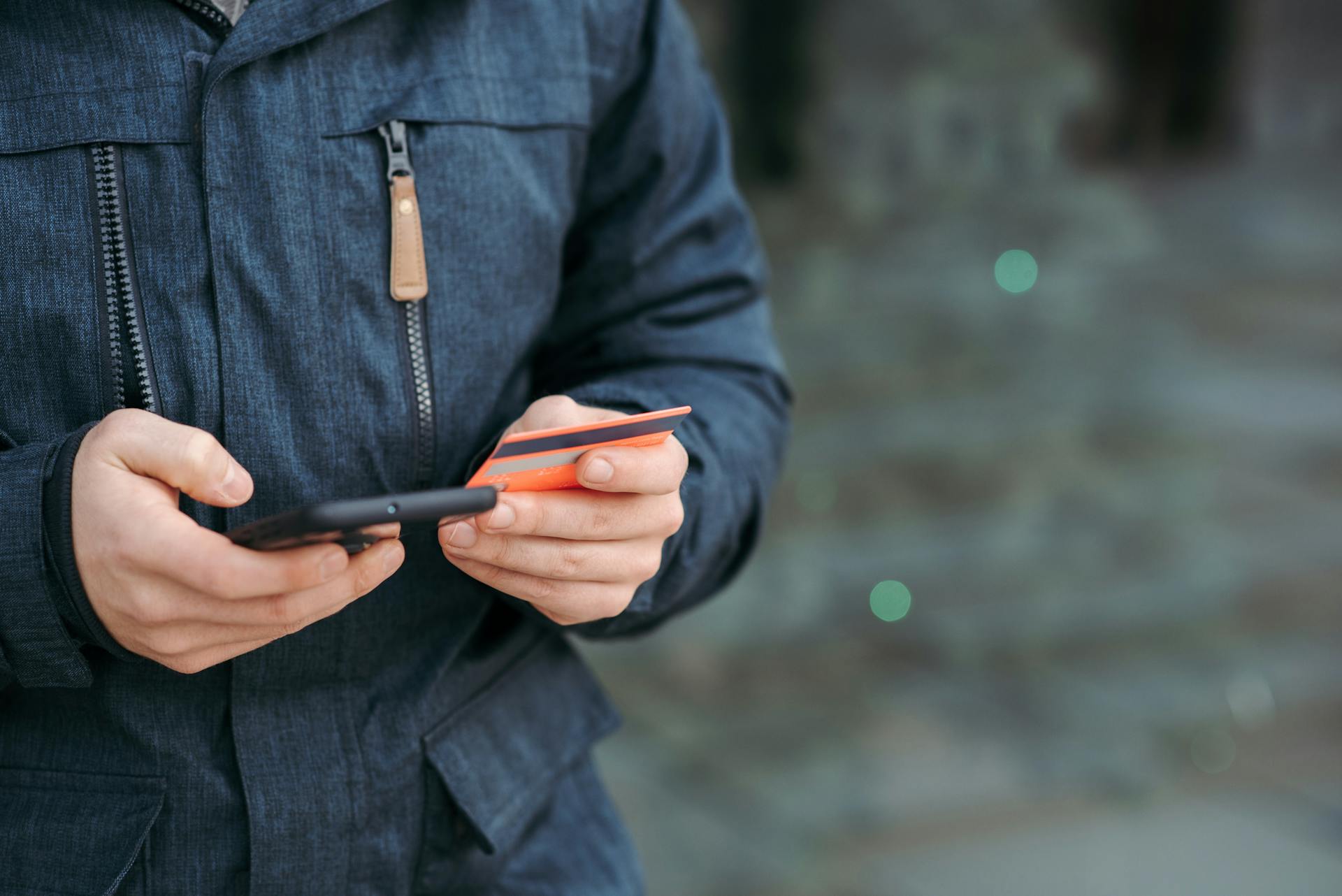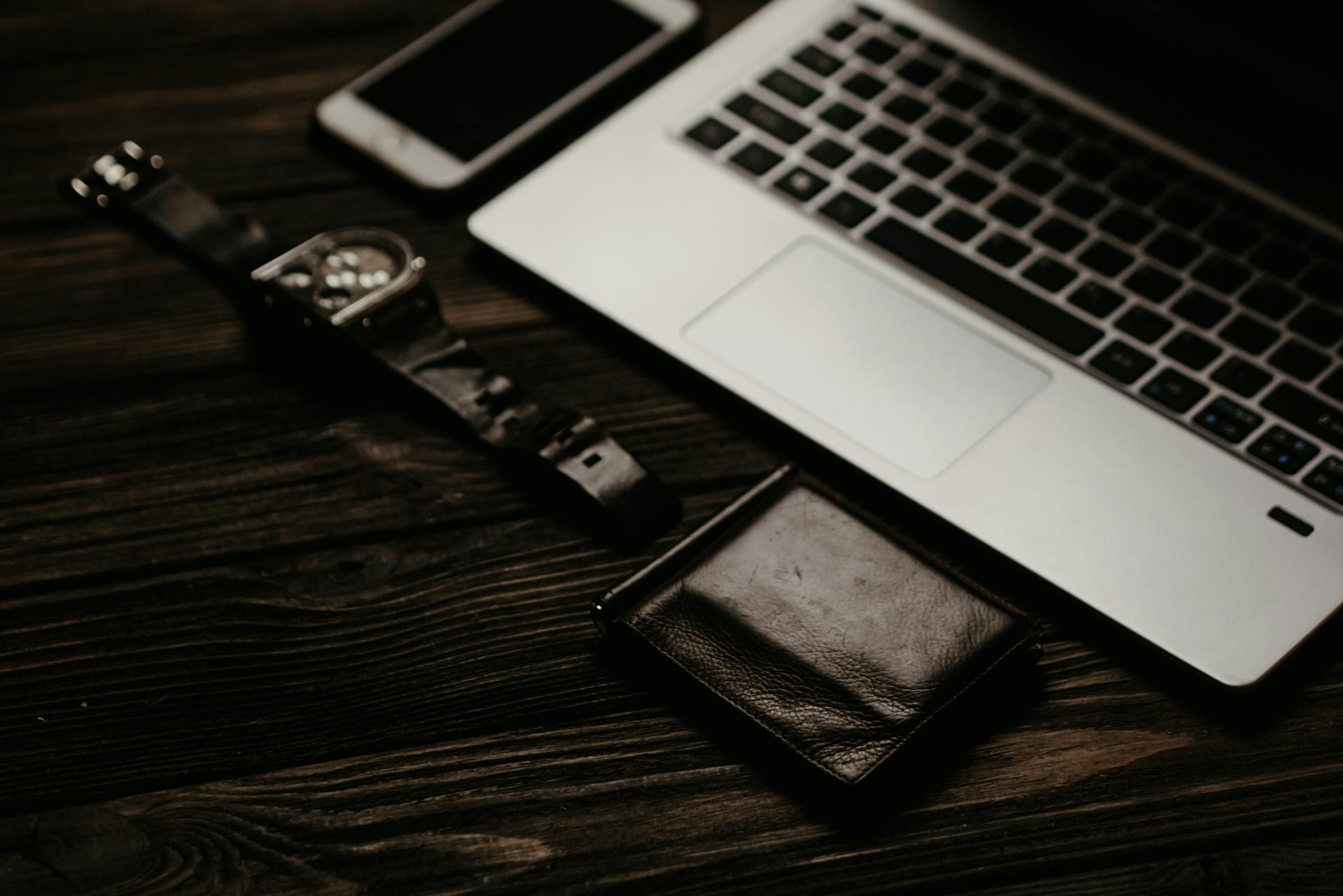
Mobile wallets have become an essential part of our daily lives, allowing us to make payments, store loyalty cards, and even receive rewards. However, with great convenience comes great risk.
Using a public Wi-Fi network to access your mobile wallet can leave you vulnerable to hacking, as seen in the case of a major retailer's data breach, which exposed sensitive customer information.
To minimize risks, it's essential to keep your mobile wallet's operating system and apps up to date, just like you would with your smartphone. This ensures you have the latest security patches and features.
A strong password or PIN is also crucial to securing your mobile wallet, as it's often the first line of defense against unauthorized access.
Readers also liked: Which Bank Gives Free Access to Airport Lounges
Adding and Using Mobile Wallets
Adding a credit, debit, or prepaid card to Apple Pay is a secure process. Information you enter on your device is encrypted and sent to Apple servers, but your actual card number is never saved on your device or photo library.
Your device-specific Device Account Number is created and stored in the Secure Element, an industry-standard chip designed to store your payment information safely. This Device Account Number can't be decrypted by Apple and is isolated from iOS and other operating systems.
To make a payment with Apple Pay in stores, you must authenticate using Face ID, Touch ID, or your passcode. Your actual payment card number is not sent to the store's point of sale terminal, but instead, a transaction-specific dynamic security code is provided along with your Device Account Number.
Here's an interesting read: Ny Mobile Id to Google Google Wallet
When Adding Cards
When adding cards to a mobile wallet, it's essential to understand what information is being shared with the service provider. Information that you enter on your device is encrypted and sent to Apple servers when you add a credit, debit, prepaid, or transit card to Apple Pay.
The card information is never saved on your device or photo library if you use the camera to enter it. Apple decrypts the data, determines your card's payment network, and re-encrypts the data with a key that only your payment network can unlock.
For your interest: Saving Account Information
Your bank, bank's authorized service provider, or card issuer creates a device-specific Device Account Number after your card is approved. This Device Account Number is encrypted and sent to Apple, where it's stored in the Secure Element on your device.
The Device Account Number can't be decrypted by Apple and is isolated from iOS, watchOS, macOS, and visionOS. Your original card numbers are not stored on Apple servers, and Apple Pay stores only a portion of your actual card numbers and a portion of your Device Account Numbers.
A unique perspective: E S a Payments
Using Apple Pay in Stores
Apple Pay uses Near Field Communication (NFC) technology between your device and the payment terminal in stores that accept contactless payments.
To send your payment information, you must authenticate using Face ID, Touch ID, or your passcode, except when you use Express Mode with a payment or transit card.
Your iPhone will present you with your default card if it detects an NFC field and is on.
Expand your knowledge: Free Online Banking No Id Required
You must double-click the side button when the device is unlocked to activate your default card for payment with Face ID or Apple Watch.
The Secure Element provides your Device Account Number and a transaction-specific dynamic security code to the store's point of sale terminal after you authenticate your transaction.
Neither Apple nor your device sends your actual payment card number.
Your bank, card issuer, or payment network can verify your payment information by checking the dynamic security code to make sure it's unique and tied to your device before they approve the payment.
Intriguing read: One - Mobile Banking
When Using Apple Pay
Using Apple Pay is a convenient way to make payments, but it's essential to understand how it works and how to use it safely.
Apple Pay uses Near Field Communication (NFC) technology to send payment information to merchants, making transactions quick and contactless.
To use Apple Pay in stores, you'll need to authenticate with Face ID, Touch ID, or your passcode, and then double-click the side button on your device to activate your default card for payment.
Check this out: What Is a Online Banking Id
Your actual payment card number is never sent to the merchant or Apple, only a Device Account Number and a transaction-specific dynamic security code are shared.
When using Apple Pay within apps or on the web, the app or website will check if you have Apple Pay enabled on your device, and you can manage this option in your device's settings.
Your encrypted payment information is transmitted to the app or website, and then re-encrypted with a developer-specific key to ensure only the intended recipient can access it.
Apple retains anonymous transaction information, including the approximate purchase amount, app developer, and app name, but this data is not personally identifiable.
You can disable the ability to use Apple Pay on your Mac in Settings on your iPhone, and also remove the ability to make payments with specific cards on your Apple Account page.
If your device is lost or stolen, you can suspend Apple Pay by placing your device in Lost Mode, and your bank or issuer will suspend your credit, debit, or prepaid cards from Apple Pay.
Take a look at this: Will Synchrony Bank Settle
To make payments safely with Apple Pay, consider using strong, unique passwords, enabling multifactor authentication, and installing extra security on your mobile device.
Here are some additional tips to keep your Apple Pay transactions safe:
- Use strong, unique passwords and consider using a password manager.
- Enable multifactor authentication, such as entering a code sent to your phone.
- Lock your phone with a password and use biometric protection, like facial recognition or fingerprint.
- Be cautious when using public Wi-Fi networks and avoid shoulder surfers.
- Regularly check your account statements for unknown charges and report them immediately if found.
- Monitor your credit report regularly to detect any suspicious activity.
Security Risks and Measures
Digital wallets offer a convenient way to make payments, but they also come with some risks. Encryption is the first line of defense in digital wallet security, and most digital wallets require multi-factor authentication before approving a transaction.
Using a digital wallet introduces several risks, including payment fraud, machine learning threats, third-party vulnerabilities, and data breaches. These risks can lead to financial losses, legal liabilities, and reputation damage for digital wallet providers.
Payment fraud is a significant risk, with fraudsters exploiting vulnerabilities to steal personal information for unauthorized transactions. To counter evolving attack methods, comprehensive security protocols are essential.
Phishing attacks are another risk, with fraudsters using emails, messages, or fake sites to trick users into sharing login details and payment information. To avoid phishing attempts, exercise caution when receiving communication asking you to click links or download files.
Discover more: How to Make Money with Your Mobile Phone
Biometric vulnerabilities are also a risk, with manipulating fingerprint or facial recognition systems potentially granting unauthorized access. Users should store biometric data cautiously and update authentication settings regularly.
To stay safe, use strong security settings, proactive notifications, and secure wallet app guidance. Consider using a VPN to boost your security when transmitting data over unsecured networks.
Here are some common digital wallet security risks to be aware of:
- Payment fraud
- Machine learning threats
- Third-party vulnerabilities
- Data breaches
- Phishing attacks
- Device theft or loss
- Biometric vulnerabilities
Best Practices for Security
To maximize mobile wallet safety, follow these best practices:
- Use strong, unique passwords for your phone and digital wallet.
- Only access your mobile banking apps and digital wallet over a secure network.
- Avoid using public Wi-Fi for digital transactions.
- Take advantage of your phone's security features.
- Regularly monitor your accounts for any unauthorized activity.
- Disable your digital wallet and payment apps if your phone goes missing.
You can also enhance your security by using app locking, biometric authentication, and remote wipe capabilities. Enable transaction signing and avoid using public WiFi networks that could expose your activity. Keeping your software and devices up-to-date is also crucial, so make sure to update your wallet software, operating systems, and antivirus software regularly.
A unique perspective: Hardware Wallet vs Software Wallet
Best Practices
To maximize digital wallet safety, follow these best practices:
Use strong, unique passwords for your phone and digital wallet. Regularly monitor your accounts for any unauthorized activity. Disable your digital wallet and payment apps if your phone goes missing.
If this caught your attention, see: I M B Bank Share Price Today
A secure digital wallet is a must for digital payments. You can use app locking, biometric authentication like fingerprints, and remote wipe capabilities in case your phone is lost or stolen.
Always maintain recent backups of your secure digital wallet to avoid losing access to funds due to device failure, loss, or other issues. Only backup to encrypted external drives or paper copies stored securely - never digitally in the cloud.
Continually update your wallet software, operating systems, internet browsers, phone firmware, and antivirus software. These patches are known vulnerabilities as they are discovered. Run frequent full system scans with your antivirus to detect potential malware or keylogger infections.
To keep your digital wallet secure, be aware of your surroundings when using public Wi-Fi. Avoid using public Wi-Fi for digital transactions. Consider using a virtual private network (VPN) to encrypt your internet traffic.
Here are some key steps to secure your digital wallet:
- Use strong, unique passwords for your phone and digital wallet
- Regularly monitor your accounts for any unauthorized activity
- Disable your digital wallet and payment apps if your phone goes missing
- Keep your wallet software and operating systems up-to-date
- Use app locking, biometric authentication, and remote wipe capabilities
- Maintain recent backups of your secure digital wallet
Vary Your Transactions
Varying your transactions is a simple yet effective way to boost your security. Avoid transferring whole-round amounts like 1 BTC at a time.
This makes it harder for hackers to track your payments or associate multiple addresses with your wallet.
Preventing and Detecting Fraud
To prevent digital wallet fraud, it's essential to employ robust security measures such as state-of-the-art encryption and tokenisation techniques. These measures can render sensitive data virtually inaccessible to malicious actors. Advanced security protocols can bolster the protection of payment information within digital wallet systems.
Employing routine system updates is also crucial. Consistently updating digital wallet apps and systems can proactively address any potential security vulnerabilities, making it significantly harder for fraudsters to exploit weaknesses. This can be achieved by enabling automatic updates or setting reminders to update regularly.
To further enhance digital wallet fraud prevention, businesses can empower the use of aiReflex, an omnichannel, high-performance, white-box AI-based fraud prevention suite. aiReflex can help identify and prevent complex fraud scenarios while reducing false positives by analysing transactions and behavioral patterns in real-time.
Here are some key steps to prevent digital wallet fraud:
- Source verification: Only acquire apps from trustworthy sources, such as official app stores.
- Enhanced authentication: Use available security features within digital wallet apps, such as PIN or facial recognition authentication.
- Network consciousness: Utilize secure and private networks to mitigate potential data interception.
- Regular monitoring: Consistently monitor your bank accounts and credit card statements for any suspicious or unauthorised activities.
Monitor your wallet and transactions closely by logging into your wallet frequently to review transaction histories and account balances for any unauthorized activity. Set up notifications for account changes and monitor public blockchain records. Report issues immediately.
What Is Fraud
Fraud refers to any unauthorized activity involving a person's digital wallet, including the use of stolen credit card information or fake digital wallets to deceive individuals into providing their payment information.
Fraudsters are constantly devising new methods to exploit vulnerabilities in digital wallet systems, such as phishing scams, malware attacks, and social engineering tactics.
To deceive users, fraudsters often use fake digital wallets, which can be created to mimic legitimate digital wallet systems.
Phishing scams, malware attacks, and social engineering tactics are some of the methods fraudsters use to exploit vulnerabilities in digital wallet systems.
Unauthorised transactions can occur when fraudsters use stolen credit card information or create fake digital wallets to deceive individuals into providing their payment information.
Discover more: First Horizon Bank Scams
How Fraud Occurs
Digital wallet fraud can occur through various means, including phishing scams, malware attacks, and social engineering tactics. These tactics exploit vulnerabilities in digital wallet systems, allowing fraudsters to deceive users into revealing their sensitive data.
Fraudsters may send emails or text messages posing as legitimate digital wallet providers, tricking users into providing their payment information. This is a common phishing tactic used to gain access to users' wallets.
Malware can also be used to steal payment information directly from the digital wallet app. This can happen when a user downloads a malicious app or clicks on a malicious link.
Fake apps and websites are another way fraudsters can gain access to users' wallets. These fake platforms may look identical to legitimate ones, but they are designed to trick users into providing their payment data.
Social engineering attacks can also be used to trick users into sharing their payment data. Fraudsters may impersonate support reps or trusted entities to gain trust and access users' wallets.
Recommended read: Ethereum Wallets
Man-in-the-middle attacks can also occur, where fraudsters intercept communication between users' devices and payment terminals, capturing payment data for misuse. This can happen when using public Wi-Fi networks.
Device theft is another way fraudsters can gain access to users' wallets. If a user's device is stolen, the thief can use it to make unauthorized transactions.
Here are some common ways digital wallet fraud occurs:
- Phishing: Fraudsters send emails or text messages posing as legitimate digital wallet providers.
- Malware: Fraudsters infect mobile devices with malware to steal payment information.
- Fake apps & websites: Fraudsters create fake digital wallet apps or websites to trick users into providing payment data.
- Social engineering: Fraudsters trick users into sharing payment data using social engineering attacks.
- Man-in-the-middle: Fraudsters intercept communication between users' devices and payment terminals.
- Wi-Fi snooping: Public Wi-Fi users face Wi-Fi snooping, intercepting data between wallets and terminals.
- Data breaches: Data breaches expose payment data stored by providers due to system vulnerabilities or hacking.
- Device theft: Stolen devices grant unauthorized access to wallets, enabling fraudulent transactions.
Preventing Fraud with AiReflex
To prevent digital wallet fraud, organisations can empower the use of aiReflex, an omnichannel, high-performance, white-box AI-based fraud prevention suite. This technology helps financial institutions identify and prevent complex fraud scenarios while reducing false positives.
AiReflex analyses transactions and behavioral patterns in real-time to identify and prevent fraudulent transactions. This ensures a safer digital wallet experience for both organisations and individuals.
By using aiReflex, businesses can reduce the likelihood of falling victim to digital wallet fraud. This is especially important as the digital landscape evolves and fraudsters become more sophisticated.
If this caught your attention, see: Venmo Transactions
Here are some key benefits of using aiReflex:
- Identifies and prevents complex fraud scenarios
- Reduces false positives
- Analyses transactions and behavioral patterns in real-time
- Ensures a safer digital wallet experience
To get the most out of aiReflex, it's essential to combine it with other preventive measures, such as advanced security measures, routine system updates, and education initiatives. By doing so, organisations can create a robust defense against digital wallet fraud.
If you're interested in learning more about how aiReflex can help safeguard your financial transactions, contact the developers today. They can provide you with more information on how to protect your organisation and customers from digital wallet fraud.
Frequently Asked Questions
What is a disadvantage of using a mobile wallet?
Using a mobile wallet may compromise your personal data security due to potential tracking of transaction data. This raises concerns about the protection of your digital information
Sources
- https://support.apple.com/en-us/101554
- https://www.microsoft.com/en-us/microsoft-365-life-hacks/privacy-and-safety/are-digital-wallets-safe
- https://www.experian.com/blogs/ask-experian/are-digital-wallets-safe/
- https://www.fraud.com/post/digital-wallet-fraud
- https://www.digipay.guru/blog/digital-wallet-security/
Featured Images: pexels.com


